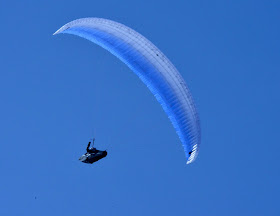UP trango X-Race SM (The hidden beauty)
After flying practically every Trango, here’s the X-Race, the newest Trango version in its light material construction.
The Trango X-race has a new and beautifully engineered shark nose ! Semi circular, small opening cells, with a complete unsheathed line construction. I actually never seen this kind of lines before. The lower A’s and B’s are heavily coated and feels like a plastic wire ! Of course, this new technology will surely prevent the aging process ! My friend tells me it looks like the kite lines.
I flew that glider at 97 all up and the next day at 94 all up. I felt that the optimum weight under the SM goes around 95.
Launching the X-race is really easy and without any hanging back at all. In strong wind, the brakes are needed to stop it from surging forward.
Before the first flight, i remembered the Trango XC3 and thought that the X-Race could bear some of its genes. It doesn’t !
The X-Race felt completely different.
 Once airborne, i could sense a more compact and homogenous feel under the X-Race. This glider moves as a whole. It seems that UP did an extensive work on it’s internal structure. Because the yaw and wobbling of the XC3 in turbulent air is no more present. Instead, there’s a new feeling of a coherent, solid, compact feel under the X-race !
Once airborne, i could sense a more compact and homogenous feel under the X-Race. This glider moves as a whole. It seems that UP did an extensive work on it’s internal structure. Because the yaw and wobbling of the XC3 in turbulent air is no more present. Instead, there’s a new feeling of a coherent, solid, compact feel under the X-race !
It resemble a bit the coherent feel of the Trango XC2(two) but with an increase in comfort and control over both the xc2 and xc3.
The SM i received had a super short brake travel, which was probably wrongly set, because just one cm of brake pull after the pulley, activated the trailing edge. So i re-adjusted the brakes by allowing a 10 cm clearance after the pulley or the trailing edge response.
Now it was perfect ! The X-race has a moderate pressure. It’s a bit more hard then the xc3 and a bit less than the xc2 and the LM6. The thermals are felt through the brakes which is excellent for a racing machine ! The brake travel is short, linear, responsive .
The X-race with it’s 6.9 aspect ratio is an agile glider in coring thermals ! The compact feel coupled with a coherent structure and a swift, direct brake response, makes circling thermals, efficient and a real pleasure ! I could say it is more agile when circling in turbulent air than the LM6, and the Trango XC3.
This good handling is integrated in a climbing beast ! The X-race climb showed me a superb climb rate in weak and in strong thermals. The X-race enters the thermal without pitching forward or back. It has the ability to "surf the rising airmass” ! That’s the best way to describe it, as it felt exactly like that !
Doing some glides in moving air showed an ability to float and move forward giving its pilot a superb glide in racing conditions at trim and at bar!
Pushing the first bar showed a medium foot pressure and a very flat polar as it seems that the speed increases without the feeling of loosing altitude. The second bar is a bit hard to push on my X-rated 6, and the glide at top speed which is 13 km/h over trim is very competitive with a solid leading edge ! IMHO, i believe that the X-race matches the performance of the today’s best ,3 liner D gliders !
The C steering is a bit hard to pull ! At top speed the pressure is slightly less on your hands as at trim, but still a bit hard to pull. Pulling the C ball has a limiter. Controlling the glider with the C balls is efficient in moderate conditions and the profile remains clean. You can easily pull the C ball all the way when thermalling brakeless, with no event, but i found it climbs best with a little brake pressure.
Ears with outers A’s are stable. Big ears with outers A’s are little un-stable.
While on bar, pulling the two connected outer B lines are stable and efficient.
Wing overs are easily done on the X-race with a playful character. 360’s also are quick to enter and easy to get out.
Pulling the brakes beyond the hip upon top landing, should be carefully mastered as the X-race doesn't accept to fly very slow with very low pulled brakes. But easy for good pilots to feel.
Pulling the brakes beyond the hip upon top landing, should be carefully mastered as the X-race doesn't accept to fly very slow with very low pulled brakes. But easy for good pilots to feel.
Conclusion: UP designer and the R&D team has done an amazing job with the X-race !
A swift handling, a solid feel, a rocket climber and impressive floater, a relatively easy to manage (high-end C) certified glider.
I believe that the Trango X-race with it’s 6.9 aspect ratio, has the highest score for the overall package of (performance/comfort/handling) in today’s C category.








